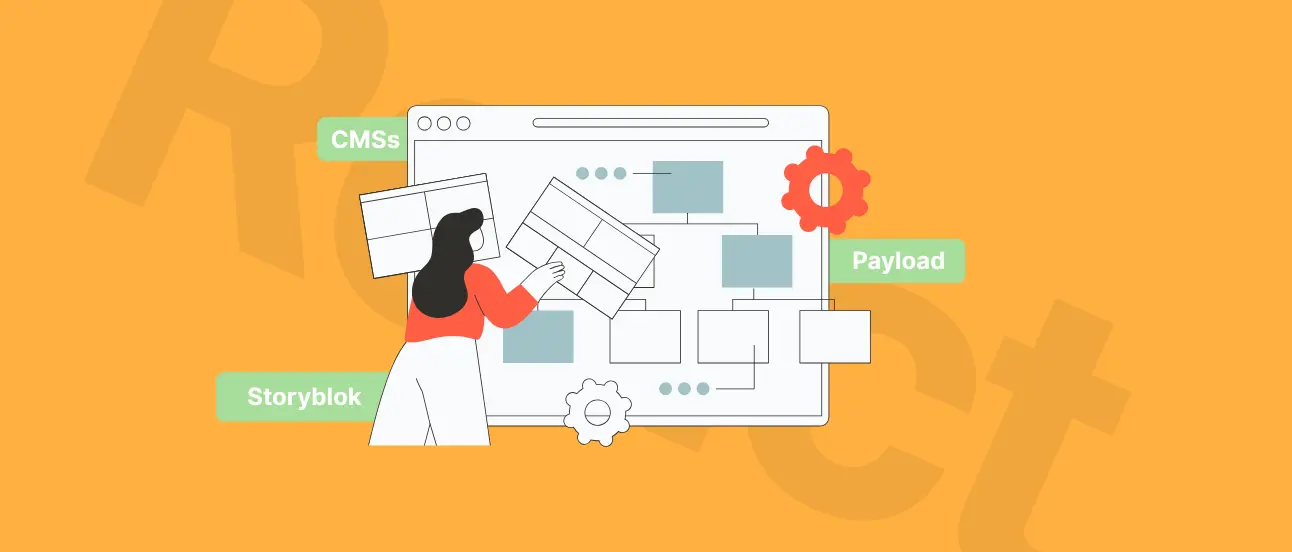12 Best Headless CMS Software Platforms - Choose The Top Solution
If you’re looking for the best headless CMS for your website, you need to know that there are around 100 of them on the market. Sure, you can opt for the most popular ones, though, these used less frequently are also worth taking a look at. In this article, we present you key features, pros and cons of selected headless content management systems.

To mark their online presence, companies have to find solutions to publish their content. One common approach is using a Content Management System (CMS), which may also serve as an integral part of the Jamstack approach to web development. The latest research shows the dynamic growth of this technology, as there are already 50% more Jamstack websites in 2021 than there were in 2020.
Top Headless CMS Solutions - Go Popular or Niche Way?
To understand the meaning of headless architecture, you need to consider the pros and cons of different headless CMS options. Finding the right one for your business can be tricky. Do you go for the most popular tools, or do you opt for the niche ones? In this article, we will explore this topic in depth and see which solutions suit different types of businesses.
More attractive price
As some tools are getting popular, usually their rates go higher. Moreover, their trial plans are typically less generous than the ones offered by less-known tools.
Higher engagement
While it is true that more experienced companies tend to provide better customer care, there’s still the risk of low engagement in their customer queries.
The headless architecture industry has been growing very fast and, therefore, the more popular companies didn’t have much time to prepare for the increased number of users.
While this is not a rule, there’s a chance their response to your queries might be unsatisfactory. Not-so-popular headless CMS tend to cherish each cooperation with their users more and therefore might be much more willing to help, not to mention potentially quicker reaction times.
Ideal for non-standard projects
The most popular headless CMS provides a lot of freedom and allows you to achieve a wide variety of results.
However, sometimes you will want a much more customized solution when, due to business needs, the necessity to use a niche technology or the desire to provide a really distinctive user experience is critical. This is where less popular headless CMS comes to the rescue.
Openness to feedback
Last but not least, the lesser-known companies are much more open to any feedback you give them. Their goal is, in the end, to reach the popularity of the competition, and the best way to achieve it is the customer satisfaction rate.
See how we create Headless web solutions that empower you to grow
Learn more
Factors to Consider Choosing The Best Headless CMS For E-commerce
Selecting the best headless e-commerce platform for your business involves considering several key factors that ensure it meets your needs today and as your business scales.
Here's a concise guide:
Scalability - Look for a CMS capable of adapting to your business growth, enabling the addition of functionalities, and handling increased traffic without compromising on performance.
Customization - Choose a content management system compatible with powerful JavaScript frameworks like Next.js or Gatsby.js. This ensures the ability to create a highly customizable front end that resonates with your brand identity and user engagement strategies.
Security - Prioritize a CMS that enhances security through the separation of the front and back ends. Features such as role-based access control, data encryption, and regular updates are essential for protecting your content and user data.
Functionality - Ensure the CMS offers comprehensive features for content management, including content modeling, versioning, workflow management, and media handling, to streamline your content processes efficiently.
Integration - The content management solution should facilitate easy integration with third-party services and tools, enabling you to leverage existing technologies and enhance your digital ecosystem effectively.
Pricing - Evaluate the pricing structure carefully. It should align with your budget and business objectives, offering a balance between cost and the value provided, considering licensing, hosting, and support services.
Incorporating these will guide you to a headless CMS solution that not only fits your current requirements but also supports your long-term digital strategy.
12 Most Popular Headless CMS Software Platforms To Check Out
Now that you know what a headless CMS is and why it might be beneficial to choose less popular ones, let’s take a deeper look at what are the advantages and disadvantages of several options on the following list.
1. Storyblok
Storyblok is the world's first interface-free headless CMS that works for developers and business users. On their site, we can find that over 68,000 developers and marketers go for Storyblok CMS development to deliver content experiences on any platform: corporate websites, e-commerce sites, mobile applications, and screens.

Benefits
It offers a free trial that is relatively generous
It is a SaaS service that comes with advantages specific to this type of product (accessibility, convenient management, scalability, increased security)
Very accessible prices for their plans
Disadvantages
Cloud-only solution
It needs some development when it comes to customization
2. ButterCMS
Butter CMS charms both web developers and content creators with its ease of use. The software developers have taken care not to overload the headless CMS with functions, which is why it acts relatively quickly.

In addition, Butter CMS comes with more useful functions. For example, support for search engine optimization (SEO) is part of the scope of delivery. Butter CMS is only available in a cloud version and thus under a SaaS model. A free version is offered, but this may only be used for non-commercial projects. It's also an example of an API-driven headless CMS.
Features
Complex & professional support for SEO
Cloud management
Its interface is administration-targeted
Benefits
It is a SaaS headless CMS that comes with advantages specific to this type of product (accessibility, convenient management, scalability, increased security)
Quick setting up & integration
Easy to use
Supports SEO
Disadvantages
The free plan isn’t very generous and might be reduced further in the future
3. Magnolia
Programmed in Java, this headless Content Management System focuses on scalability. In general, however, Magnolia is aimed at large companies that want to realize an extensive web presence.
The headless CMS is therefore only one of the solutions offered. An open-source version is available, but its range of functions is severely limited compared to the paid version. On their official website, we can find that 400+ market leaders have already built their digital experiences with Magnolia.
Features
Allows you to publish content without being tied to a specific visual template or frontend structure
Offers backend content management capabilities through advanced visual editing tools, for a simplified content management and editing process, as well as a better creation experience
Benefits
Allows scalability & extensibility, which is much appreciated by the users
It is a SaaS headless CMS that comes with advantages specific to this type of product (accessibility, convenient management, scalability, increased security)
Disadvantages
It’s an advanced tool that can seem complicated to use at times. Therefore, it demands an experienced team of developers
As a result of its extensity, there are some concerns about how the price might increase in the future
4. Directus
Directus is one of the particularly simple Content Management Systems. Due to the intuitive interface, beginners can work well with this system. This open-source tool scores particularly well with its comment and note function, which proves to be very useful.
In addition, files can be uploaded and managed via Directus. Users do not have to worry about data loss either, as the tool tracks all activities, with rollbacks possible at any time. On their official website, we can read that more than 4,600 users are now in their community.
Features
User-defined SQL databases in connection with a dynamic API (Application Programming Interface)
Open-source & free self-hosting or, alternatively, its own on-demand cloud service
Comment & note function (very intuitive, according to developers)
File upload & management
Benefits
Not many other CMS allow uploading and managing files
Free community cloud service; no artificial limitations or paywalls (e.g. Standard Cloud starts at $25 a month with no quotas, and there's a completely free Cloud Tier available)
No risk of losing data, as Directus always tracks all activities
Disadvantages
Some issues with the pre-uploading of big video files
5. Payload
Payload is an open-source, developer-first headless CMS designed for teams that need full control over their content, data, and infrastructure.
Unlike many SaaS-only platforms, Payload gives businesses the freedom to self-host, customize deeply, and adapt the CMS to even the most complex product requirements.
It’s an excellent choice for companies seeking flexibility, security, and long-term scalability in a modern TypeScript-powered stack.

Features:
REST, GraphQL, and Local APIs for maximum integration flexibility
Role-based access control and configurable permissions
Built-in auth system with support for multiple user collections
Media library with upload handling, image processing, and cloud storage integrations
Multi-tenant and multisite capabilities through plugins and access rules
Benefits
Full control over hosting, data, and compliance
Extremely flexible content modeling powered by TypeScript schemas
Built-in authentication, file storage, and access control
Highly customizable, making it suitable for complex or unique product requirements
Disadvantages
Requires self-hosting or DevOps involvement
Not as turnkey as SaaS CMS platforms; more setup required for non-technical teams
Comparison of 15 Headless CMS for Jamstack Websites
If not WordPress, which tool for content management would be the most suitable for your particular needs and requirements? To get the most reasonable and comprehensive answer, you’d better contact web development experts (like us, for example). Nonetheless, we prepared a headless CMS comparison for you to start with!
CHECK THE ARTICLE
6. Pimcore
Pimcore is the leading open-source digital experience management platform used more than 80,000 times by leading companies around the world (Pimcore, 2022). It is a consolidated platform of content, community, and commerce applications across every customer interaction.

It integrates Product Information Management (PIM)/Master Data Management (MDM), Digital Asset Management (DAM), Web Content Management System (CMS), and e-commerce capabilities into a single open-source suite. It’s not a CMS at its core, however, it can be transformed into one with developers’ work.
Features
Content library with cataloging and categorization
Data quality control
Many options for managing content
Third-party integrations
Collaboration Tools
Benefits
The possibility of choosing a free plan
It has quite a big community of users, which can share useful knowledge and support on some issues
Pimcore is appreciated for its quick and reliable customer care
Disadvantages
It’s quite pricey for a solution that is not popular yet, however, you can modify your plan
See how we create Jamstack web solutions that empower you to grow
Learn more
7. Statamic
Statamic is a flat-file CMS powered by Laravel. Contrary to its most direct competitor, October, Statamic seems to be more accomplished as a full product. What’s most interesting, however, is that even though Statamic is a three-person team, there are nearly 30,000 registered Statamic developers (Statamic, 2022).
Features
Access Controls/Permissions
Electronic forms
Versioning
Text formatting
Customizable templates
Content publishing options
Full-text search
Benefits
Very accessible pricing
Easy installation and integration with other tools
A sleek, modern interface
Disadvantages
The communication style of this company is sometimes questionable: not every team will like it
Functionalities could still be developed and improved
8. Dato CMS
This is an open-source web content management for businesses and professionals. This software package is commonly used by small and medium-sized businesses, as well as by companies in the Services and Tertiary sectors.

Features
Online assistance, e.g. forum, tutorials
Technical support via phone, mail, and chat
Benefits
The DatoCMS software comes with a private cloud and custom SLAs
Easy and efficient access to support and customer care
Disadvantages
The interface could be more user-friendly
9. Amplience
Amplience is an API-driven headless CMS for B2C and B2B businesses. It allows the creation of dynamic content and experience at scale without developer intervention. Amplience serves over 350 of the world's leading brands including Crate & Barrel, Tumi, Traeger Grills, Argos, OTTO Group, Primark, and Very Group (Amplience, 2022).

Features
Convenient access Controls/Permissions
Electronic forms & customizable templates
Version, workflow & document management
Many accessible content publishing options
Benefits
Allows the planning, creation, and delivery of content from one place with previews across multiple contexts and channels.
No need to have experienced developers on the team to manage content
Disadvantages
It’s mostly suited for bigger projects, and the plan rates indicate that as well
Not suitable for projects that are not primarily focused on B2C or B2B cooperation
10. Plasmic
Being a slightly different product on this list, Plasmic allows developers to build websites with easy-to-grasp, visual tools and methods.
Features
Visual toolset
Has an optimization section that helps with the growth of the website
Benefits
No need to work with experienced developers, as Plasmic is very intuitive and allows for projects to be created via an easy & visual toolset
Greatly helps with improving optimization and page visibility
Disadvantages
It’s unique and therefore not every team will like it, as it’s a very visual tool that is less focused on the extensive functionality of a website
11. Enonic
Enonic is a modern content platform and headless CMS navigating the high wire between developer freedom and editorial power usage. With Enonic, there are many ways to reach Rome. Use it as a digital experience platform with templates and landing pages, use it as a purely headless CMS to create, curate, and distribute structured content to any channel, or use it as a mixture wholly dependent on your requirements.

Due to its decoupled nature, developers can use Enonic with their favorite front-end frameworks and tools – like the Next.js integration that showcases server-side rendering with React. On the other side, content editors can work in a familiar and efficient environment, complete with tree structure, visual page editing, and in-context previews.
Features
Open source
Can be hosted by Enonic, in any cloud or on-premise
Flexible schema system
GraphQL API
Benefits
User-friendly editorial environment
SEO support
Use any front-end
SDK and CLI get developers started quickly
Disadvantages
The Enonic platform does not offer any out-of-the-box functionality for eCommerce, AB testing, or personalization – instead encourages integration with “best of breed” vendors
There is no free alternative in the Enonic Cloud (besides a trial)
12. Sanity
Sanity is an open-source headless CMS used by over 100,000 people around the world. It’s a common, frequent choice of companies that want to benefit especially from data-driven content solutions and, thus, the creation of dynamic, interactive, and highly customizable websites, platforms and apps.

Sanity is used by Nike, Figma, Remarkable, Cloudflare, or Sonos.
Features
A tool designed to be highly flexible and extensible
Highly customizable either by using plugins or by writing your own React components
Content treated structurally, as data
WYSIWYG rich text editor
Real-time collaboration for content teams
Group posting
The Sanity Studio is an open-source React app
Benefits:
Ultra-friendly for users
The workflow is nice and steady
Great documentation and data model
Easy to integrate with
Gives great freedom to developers
Schemas are easy to write and they’re included in the code
Disadvantages:
Not very great for developers working simultaneously (independent work on code isn’t time-efficient)
Requires advanced skillset to organize the CMS
The priority to use GROQ, a Sanity-specific language, instead of industry-standard GraphQL (can be seen as an advantage, though)
Dajemy Słowo wanted to establish the agency’s position in a new digital era: enthusiastic, highly performant, and incredibly user-friendly. We joined them on their mission!
5/5
Clutch review
0.5 s
FCP
0
Attacks

Expert Insights on Choosing the Best Headless CMS For Your E-commerce Business
Whichever headless CMS you choose, do it thoroughly and comprehensively - it will pay off.
The above list isn't exhaustive - you're free to choose from over 100 headless content management systems present on the market.
At Naturaily, we happily make things easier for you by doing an analysis of your business needs and requirements. On this basis, we present you with recommended options, tailored to the goals you determined or pain points you'd like to tackle.
Just drop us a line and we'll do the magic!
Let’s Create a Great Website Together
We'll shape your web platform the way you win it!
More posts in this category

December 09, 2025 • 12 min read
READ MOREWhat is Headless Architecture? Benefits, Risks, and When It Makes Sense
If you’re hearing “headless” in every technology conversation and quietly thinking “Is this actually for us, or just another buzzword?,” this article is for you.

December 02, 2025 • 8 min read
READ MORESvelte in 2026: Why It’s (Still) a Big Deal - Svelte 5 Features, SvelteKit, Pros & Cons
Svelte 5 and SvelteKit offer a faster, simpler approach to building modern frontends. Here is what’s new, how the framework works today, where it fits in real projects, and when alternatives might be a better choice.

November 26, 2025 • 10 min read
READ MOREBest Headless CMS for React (2026): 15 Top Picks + When to Use Each
React works well with a headless CMS because it speeds up development, improves performance, and keeps content operations simple. You will see how platforms like Storyblok, Sanity, Hygraph, Prismic, Strapi, Payload, and Contentful integrate with React and Next.js, and what makes each one a better fit for different team sizes and needs.
